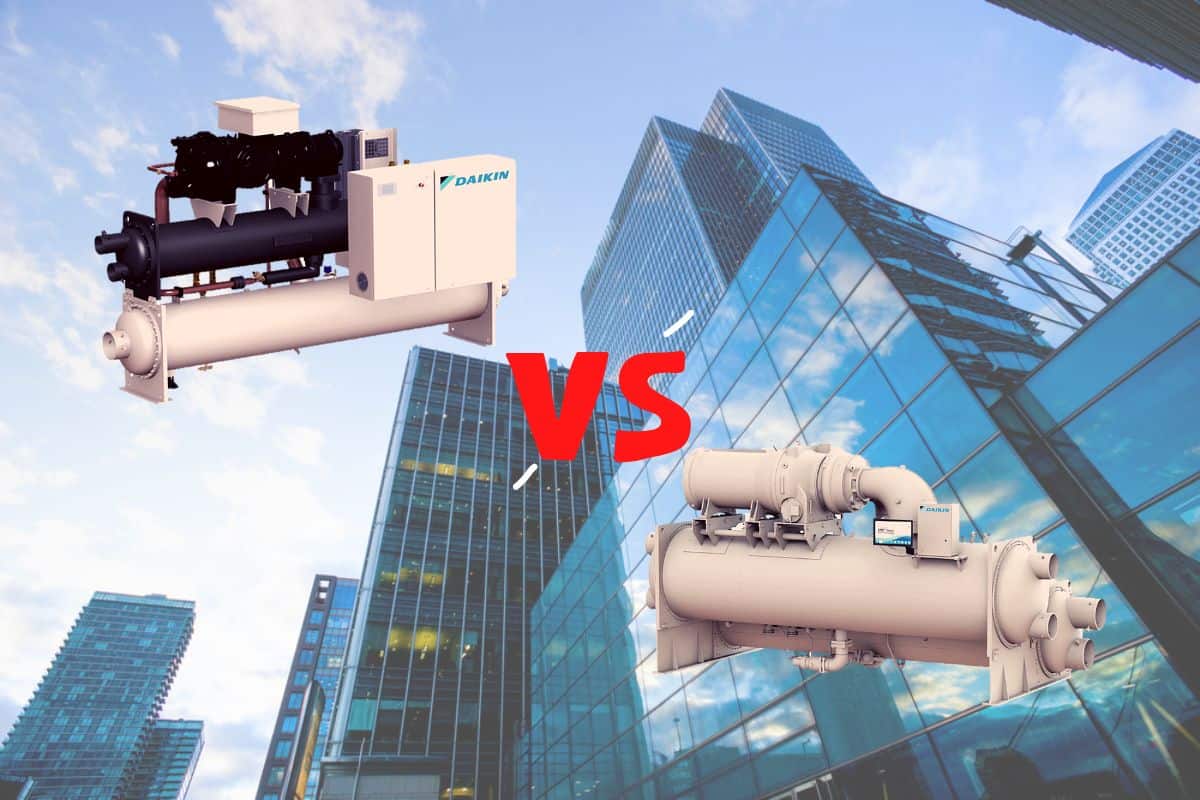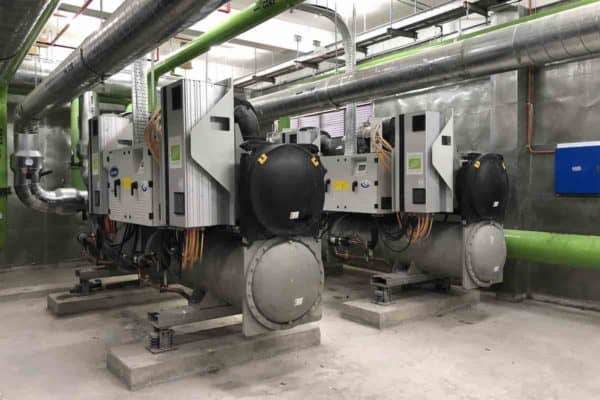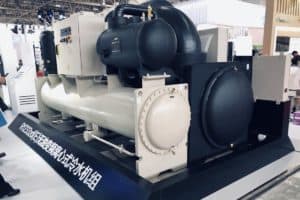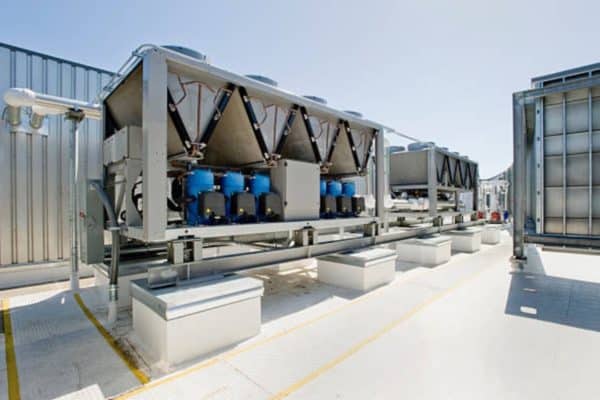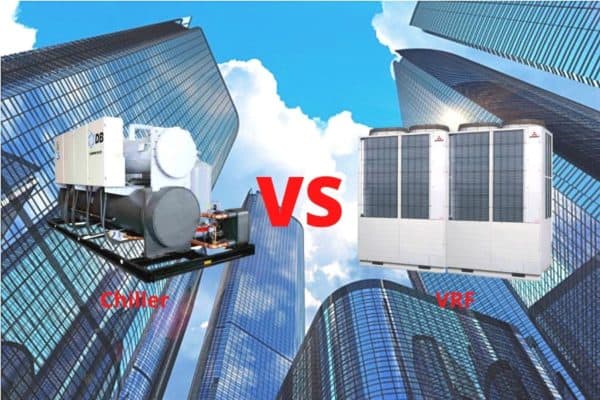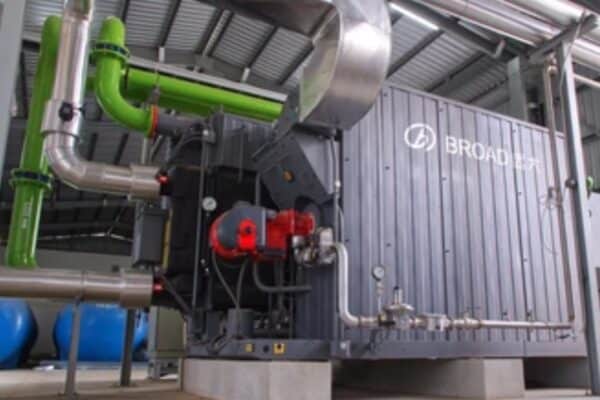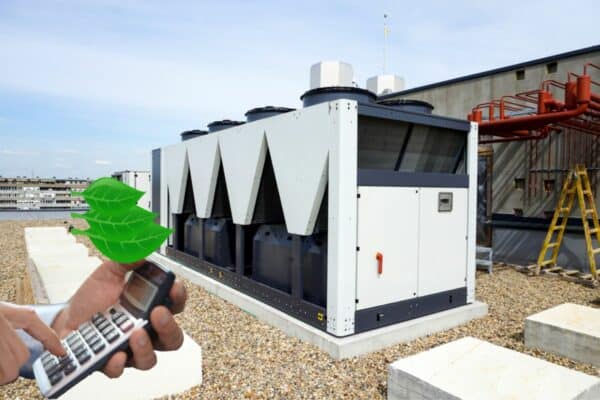Centrifugal Chiller vs Screw Chiller (Chiller Selection Guide)
Large buildings often need chillers for cooling. But, there are many types of chillers available on the market. Many engineers find it particularly difficult to choose between a centrifugal chiller and a screw chiller. So, how do you select a chiller?
Water-cooled centrifugal chillers and water-cooled screw chillers are the two most common types of chillers found in commercial buildings such as hotels, office towers, shopping malls and hospitals.
At a glance, below are the major differences between centrifugal chillers and screw chillers:
| Comparison | Centrifugal Chiller | Screw Chiller |
|---|---|---|
| Capacity Range | 200 RT to 4000 RT | 80 RT to 700 RT |
| Full-Load Efficiency | ≤ 0.56 kW/Ton | ≤ 0.64 kW/Ton |
| Part-Load Efficiency | ≤ 0.45 kW/Ton | ≤ 0.49 kW/Ton |
| Chiller Surge | Yes | No |
| Common Applications | Office and Malls | Hotels and Hospitals |
The differences between a centrifugal chiller and a screw chiller are quite known. In short, centrifugal chillers are better for large cooling applications while screw chillers are better for small cooling applications.
However, when it comes to medium cooling applications such as 300 RT to 500 RT, the two types of chillers overlapped. Some people prefer the centrifugal type while others prefer the screw type.
So, to understand which chiller is the best for you, we need to go through the characteristics of centrifugal chillers and screw chillers as well as the selection parameters.
Centrifugal Chiller
Water-cooled centrifugal chillers are primarily designed for large cooling applications. A typical centrifugal chiller can have a cooling capacity anywhere from 200 RT to 4000 RT.
Generally, there are 3 variants of centrifugal chiller; a) single compressor, b) dual compressor and c) oil-free magnetic bearing compressor (sometimes known as turbocor).
Needless to say, the single compressor type is used for the lower end of the centrifugal chiller capacity while the dual compressor type is used for the upper end of the centrifugal chiller capacity.
Normally, the cost of the single and dual compressor types is lower than the magnetic bearing type.
Excluding the magnetic bearing type, centrifugal chillers are known to be good at full load. This means that centrifugal chillers can maintain high efficiency when operating at near maximum capacity.
Below is an example of the part-load performance of a 1000 RT water-cooled centrifugal chiller:
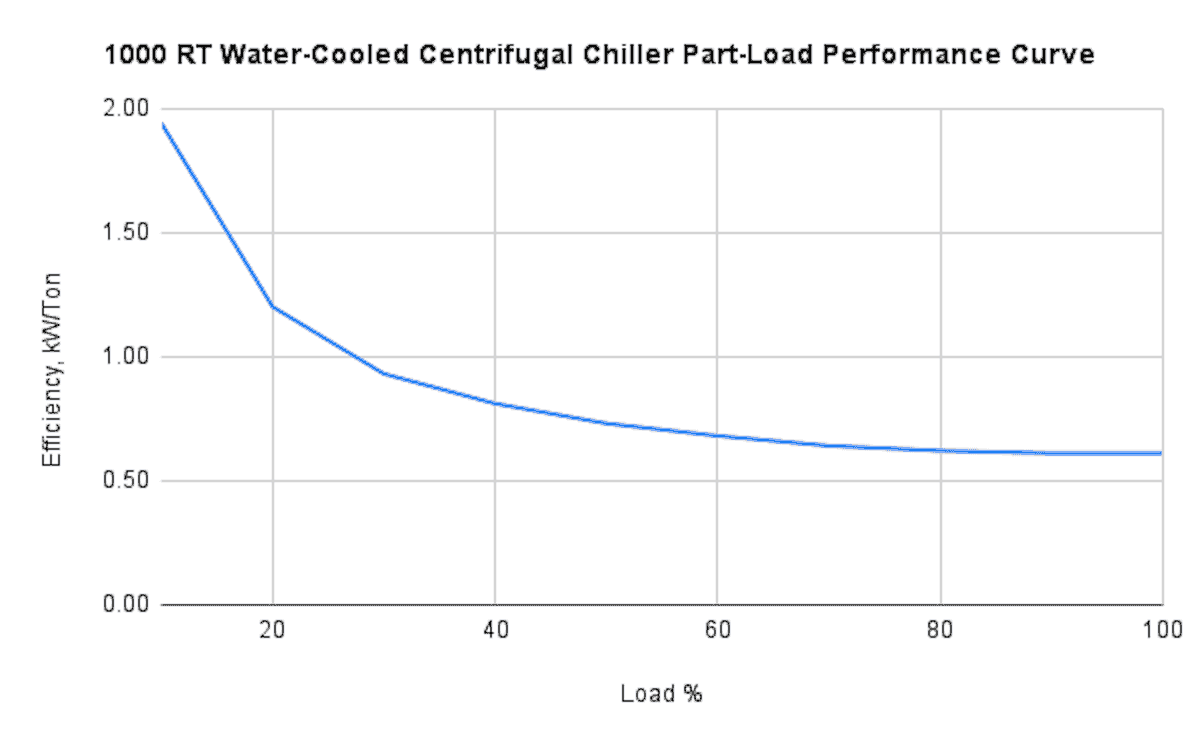
From the above graph, we can see that the efficiency of the centrifugal chiller (kW/Ton) remains flat when the load is around 70% to 100%. As the load drops below 60%, the efficiency of the centrifugal chiller reduces exponentially.
On top of that, centrifugal chillers are prone to surging when operating at below 50% load. However, modern centrifugal chillers have built-in features that allow them to operate as low as 20% load without surging.
To learn more about chiller surge, see my post Chiller Surge: Symptoms, Causes & Preventions.
Moreover, centrifugal chillers are usually relatively expensive at low capacity and optimized at high capacity.
Therefore, water-cooled centrifugal chillers are the preferred type for large cooling applications. But, there is more to it.
Let’s take a closer look at water-cooled screw chillers before we proceed to the selection process.
Screw Chiller
Screw chillers are known to perform best at part-load. In fact, many water-cooled screw chillers are designed at about 60% to 70% load.
Below is an example of the part-load performance of a 600 RT water-cooled screw chiller:
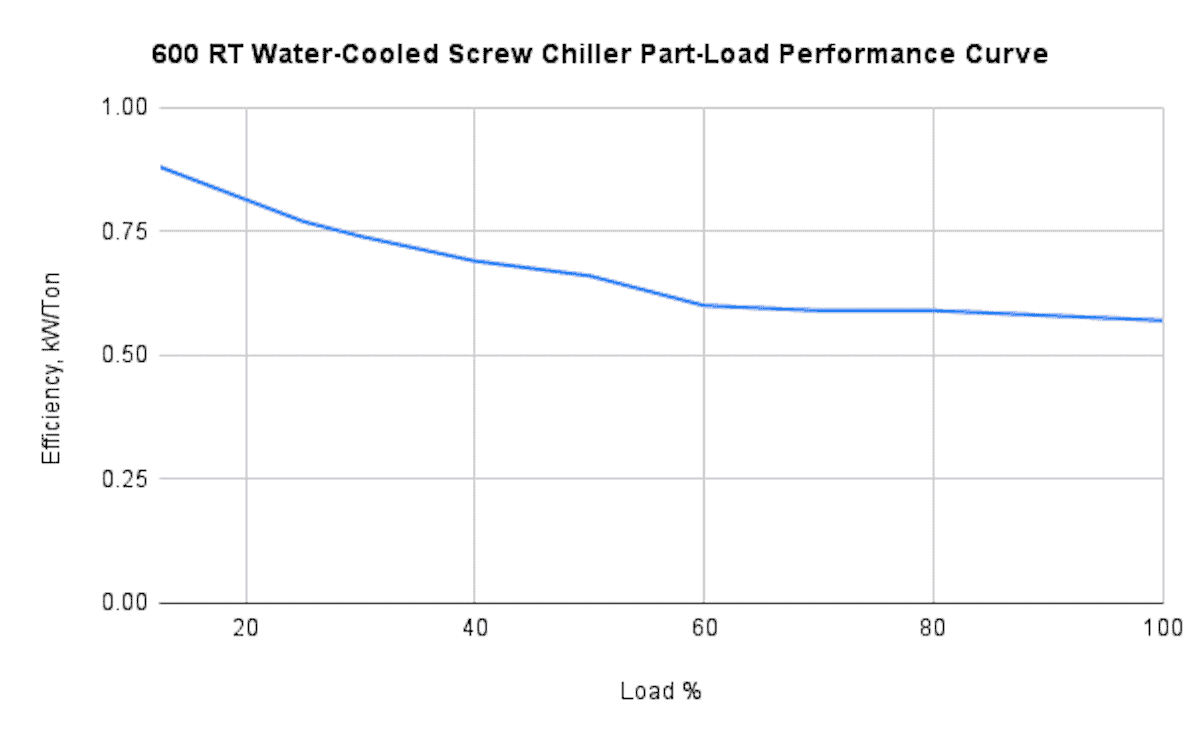
From the above graph, we can see that the overall curve is flatter for the screw chiller. Although both the centrifugal chiller and the screw chiller see a drop in efficiency at below 60% load, the screw chiller maintains a relatively better efficiency.
In addition, unlike centrifugal chillers, screw chillers don’t surge at below 50% load.
Moreover, a screw chiller is usually cheaper than a centrifugal chiller of the same capacity. Hence, screw chillers are often preferred over centrifugal chillers for low cooling applications and even certain medium cooling applications.
Nonetheless, the major downside of water-cooled screw chillers is the relatively narrow capacity range compared to water-cooled centrifugal chillers.
A typical screw chiller only has a cooling capacity range from 80 RT to 700 RT. If you need a single chiller with more than 700 RT, a screw chiller is out of the question.
But, what if you need a chiller with 450 RT?
So, let’s take an example and go through the chiller selection process between the centrifugal type and the screw type.
On a side note, if you want to quickly learn about chilled water system, you can get my Chilled Water System (eBook). If you’re into design, you can enroll in my Chilled Water System Design Course where I teach you various design procedures with tons of examples.
Chilled Water System Design Course
Learn how to design a chilled water system with AHU/FCU selection, chiller sizing, cooling tower sizing, pump sizing, piping design, ductwork design and more.
Chiller Selection Guide – Centrifugal vs Screw
Usually, chillers are primarily selected based on the required capacity. Apart from that, the type of chiller that has the highest efficiency is preferred.
Although the chiller selection guide in reality is much more complicated, the following considerations can give you some ideas about the thought process going on behind the scene when choosing between the centrifugal type and the screw type.
1. Determine the Required Capacity
The first thing we need to know is the required capacity. As mentioned earlier, the capacity range of centrifugal chillers and screw chillers is different.
Below is the capacity range of a chiller based on different compressor types:
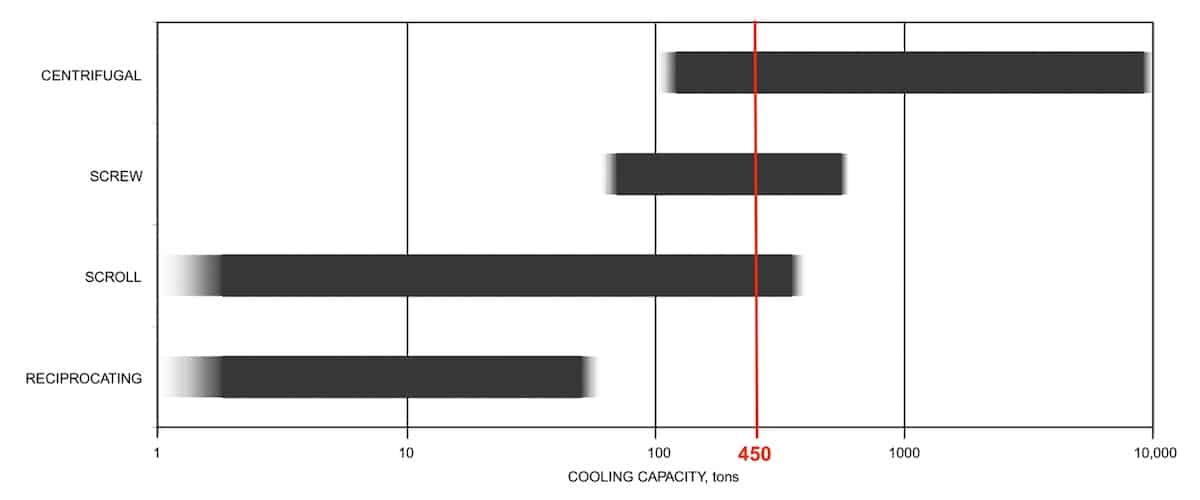
As you can see, if you need a chiller with more than 700 RT, a centrifugal chiller is your only option.
However, if you need something like a 450 RT chiller, you’ll have an option to choose between a centrifugal chiller and a screw chiller.
So, let’s narrow down the selection process.
2. Compare the Full Load Efficiency
Centrifugal chillers mostly have better full load efficiency than screw chillers, especially if you opt for high-efficiency models or magnetic bearing models.
On average, the full load efficiency of a water-cooled centrifugal chiller is around 0.56 kW/Ton or less. Meanwhile, the full load efficiency of a water-cooled screw chiller is averagely around 0.64 kW/Ton or less.
In other words, a centrifugal chiller is about 15% more efficient than a screw chiller at 100% load.
Therefore, if you expect to run the chiller at 100% load for most of the time, centrifugal chillers are preferred over screw chillers. For instance, office buildings have a consistent load because people go to work and back from work at about the same time.
Conversely, if you expect to run the chiller at different loads throughout the day, screw chillers may be better than centrifugal chillers. For instance, hotels have inconsistent loads because hotel guests go in and out randomly.
3. Check the Part-Load Performance
For part-load efficiency, centrifugal chillers are still superior to screw chillers. However, when there is a chance the chiller will need to operate at below 60% load, screw chillers are worth considering.
As mentioned earlier, the efficiency of centrifugal chillers drops exponentially at below 60%. Furthermore, centrifugal chillers may start to surge at below 50%.
For example, on certain months, some hotels may have an occupancy rate as low as below 50%. Consequently, the cooling demand (cooling load) can drop below 50% where centrifugal chillers start to struggle.
Even for an office tower, the initial stage where tenants are yet to occupy the floor, the cooling load can be very low which may cause trouble for centrifugal chillers.
So, even though centrifugal chillers have higher efficiency, screw chillers may be a wiser choice in certain applications.
4. Finalize with ROI Comparison
If you need a chiller with about 450 RT and the cooling load is expected at 60% and above, both centrifugal chillers and screw chillers are viable and thus, you need to do a detailed ROI comparison.
ROI (return on investment) is sometimes also known as the total cost of ownership. Essentially, you compare everything from the purchase cost to installation, maintenance and operating cost.
In addition, you should also consider who will be paying for the electricity bill.
For example, some developers construct buildings to rent out and the electricity bill is to be paid by the tenant. In this case, the developers have less concern about the efficiency of the chiller.
Contrarily, if your client is going to operate the building by themselves, high chiller efficiency is the top priority.
Under certain conditions, a 450 RT water-cooled centrifugal chiller can be as much as 40% more expensive than a 450 RT water-cooled screw chiller. So, the initial purchase cost plays an important role as well.
As far as I know, people usually go for centrifugal chillers when the required capacity exceeds 500 RT. Hence, the true borderline or comparison between centrifugal and screw chillers is somewhere around that 300 RT to 450 RT range.
Conclusion
One of my friends once said: “one chiller fits all does not exist”. Essentially, the best type of chiller is depending on factors such as the required capacity, the application (load profile) and the overall return on investment.
The best chiller is the one that runs at the most optimal efficiency for most of the time thereby yielding the best return on investment for the owner.
Once again, you can get my Chilled Water System (eBook) to quickly learn more about chilled water system. But, if you want to learn how to design a chilled water system from start to end, I encourage you check out my Chilled Water System Design Course.
Chilled Water System Design Course
Learn how to design a chilled water system with AHU/FCU selection, chiller sizing, cooling tower sizing, pump sizing, piping design, ductwork design and more.
If you have anything to add (or ask) about this topic, leave a comment down below!


